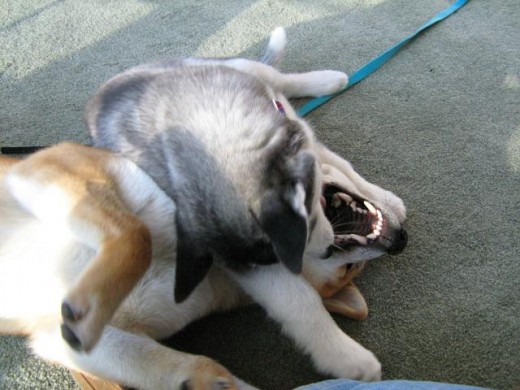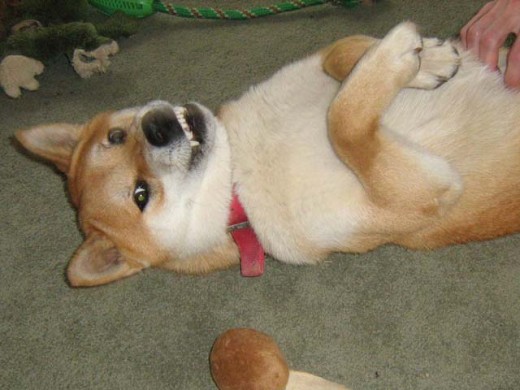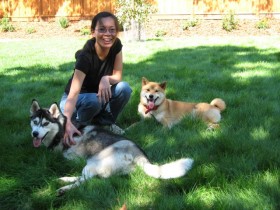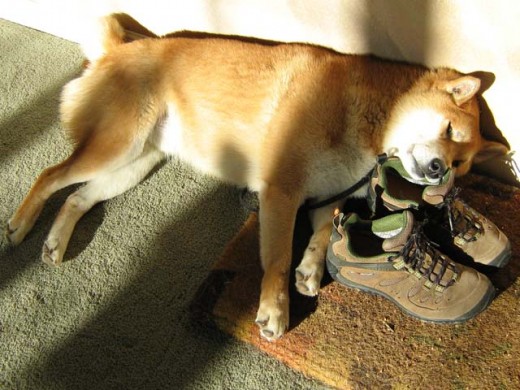Why do puppies bite?
Unlike us, puppies do not have opposable thumbs, so they manipulate stuff with their mouths, in the same way that we manipulate stuff with our hands. New puppies or young dogs will try to put everything into their mouths, because they are curious about objects and their surroundings.
Therefore, puppy biting is normal canine behavior.
Puppies also play with each other through play-biting. When a puppy bites too hard during play, his siblings may yelp and stop interacting for a short duration. Biting too hard on an adult dog (e.g. their mother), may also result in an undesirable consequence. In this way, puppies learn social rules and boundaries.

There is nothing wrong with dogs or puppies biting each other during play, but it is crucial to teach them to be careful with their mouths when interacting with people.
A puppy who is not taught this lesson, may become a danger to all the people around him, including his owners. Play-biting with humans, especially seniors and children, may cause accidental injuries and ultimately result in forced euthanasia.
If our puppy is biting us or others in an uncontrolled way, it is best for everyone not to engage in rough play with him. Also, do not play games that encourage biting such as Tug-of-War.

How to Deal with Puppy Biting
I deal with puppy biting by training my dog in three important areas –
1. Bite inhibition training
People have thinner and more sensitive skins than dogs do. Therefore, one of the first things that I teach my puppy is to control the force of his bites, especially when interacting with me and others.
2. Redirection and no-bite conditioning
When my dog bites on people, clothing, or unsanctioned objects (e.g. books, wires), I no-mark to let him know that it is an undesirable behavior. Then, I redirect his mouth onto something acceptable, and reward him for doing the right thing. In this way, he learns which objects are off-limits, as well as what he should do instead.
3. Excitement and self-control
An over-excited puppy, who lacks self-control, will tend to bite more often and with greater force. By managing my puppy’s excitement level and teaching him to control his impulses, I set him up for success, and reduce the number of instances where he engages in bad biting behavior.
An ounce of prevention is worth a pound of cure.
~~[Benjamin Franklin]
When dealing with puppy biting issues, I always try to stay calm but firm. I do my best to catch problems early on, and fix them before they escalate in degree and frequency.
If a dog is causing puncture wounds, or escalating his aggressive biting behavior, it is best to get professional help as soon as possible.
In this article, I discuss bite inhibition training and no-bite conditioning. For more on managing a puppy’s excitement level, please refer to Managing Puppy Excitement and Self-Control.
Bite Inhibition


Some dogs may have low bite thresholds. This means that they resort to biting or aggression even with fairly low, seemingly harmless stimuli.
One of my dogs, a Shiba Inu, can get mouthy when he is excited or frustrated, when I restrain him, when I stop him from doing something, and much more. Because of this, it is extremely important to train him to have good bite inhibition.
I start bite inhibition exercises as soon as I bring a puppy home. Even though puppy teeth are sharp, a puppy does not have the jaw strength of an adult, and is not capable of doing as much damage. Once my puppy has a soft mouth, I train him to stop biting on people.
Hand-feeding is a good way to teach our puppies to control the force of their bites. I hand-feed my puppy at least some of his kibble every day. If he bites too hard when getting his food, I do a sharp ouch or yelp, and ignore him for a few seconds. This teaches him that if he bites too hard, the food stops.
If my puppy is taking food from me gently, I praise him and keep the food coming. Often, I will combine hand-feeding with puppy obedience training and dog grooming sessions. Hand-feeding can also help prevent food aggression issues, so I continue this practice throughout my dog’s life.
We can also get Ian Dunbar’s book After You Get Your Puppy, for an overview of bite inhibition training.
Initially, Dunbar may come across as somewhat alarmist. We may feel that if we do not meet his somewhat unrealistic dog socialization and puppy training demands, things are going to go badly. I just try to ignore the alarmist talk, and focus on the bite inhibition and handling exercises, which are quite useful.
I am very thankful that my puppy (now adult dog) has a soft mouth. Because my Shiba Inu has good bite inhibition, we were able to solve many of his subsequent issues, which would have been difficult to deal with if he were biting at full strength.

When Our Puppy Bites …
When our puppy bites, it is important NOT to jerk our hand away. If we jerk away, we will likely get scratched. In addition, sudden and quick movements may make our puppy think that it is a fun game. This rewards the biting behavior, and encourages him to bite on us even more.
In the worst case, quick movements can activate a dog’s prey drive, and encourage aggressive behaviors. Therefore, it is important to control this reflex action, and stay still. In addition, I give a no-mark or yelp as a puppy might do to his litter-mates, when they are playing too rough.
I usually yelp when it is an accidental dog bite, for example when my dog gets his teeth on me while taking food out of my hand. Yelping is also appropriate for puppies that are still learning the rules. Otherwise, I use No for adult and adolescent dogs, who should know better.
After the no-mark, I always follow-up with a positive command, e.g. redirect him onto a toy.

1. Redirect Our Puppy onto a Toy

This technique is especially useful for an untrained puppy. It lets him know that it is ok to bite on a toy, but not ok to bite on people.
For example, my dog gets excited and starts biting when I scratch his tummy. Therefore, I used that as a training exercise to get him to bite on a toy, instead of on my hand. Since I can start the exercise anytime I want, I control the environment and make sure that I have multiple soft toys nearby for use. I make sure to reward my dog very well with food and affection when he redirects, so that I further reinforce the behavior.
A toy can also be useful for those cases where the puppy is losing control, and getting a bit too excited or frustrated. Giving him something to redirect his excitement or frustration at, may help to calm him down.
If I do not have a toy handy, I can also redirect by giving my puppy an alternate and simple command that he knows very well, e.g. Sit.

2. Withdraw Attention and Affection
Often, a puppy starts to bite at us because he wants to play or interact. Therefore, if my puppy does not respond to my redirect, then I withdraw my attention and affection. I do this by standing up, folding up my arms, and ignoring him. I make sure not to give any eye contact, not to talk, and not to engage him in any other way.
This is also called a timeout lite.
By doing this, my puppy learns that-
Out of control biting and jumping = No play, no attention, and no affection,
Gentle interaction = Play continues, food rewards, and extra attention.
Sometimes, my puppy may get too excited and escalate his behavior by biting on feet, or jumping and trying to bite on clothing. This is something that I absolutely do not allow because it can be very dangerous, especially with children and the elderly.
If my puppy escalates his behavior, I no-mark, say “Timeout”, and take him to a low stimulus timeout area immediately.
NOTE – In general, I try to set my dog up for success by managing his excitement level. In this way, I keep timeout-necessary episodes to a minimum.
3. Timeout

Most dogs value their freedom to roam around the house and backyard. Dogs are also pack animals, and like being with both human and canine members of the family. Since a timeout takes away both of these things, it is an extremely effective method of dog discipline.
When giving my dog a timeout –
- I make sure to put him in a really boring room, with no windows that he can reach. Currently, my dog’s timeout area is the laundry room.
- I check that the room is safe, and contains nothing that he can chew, play, or interact with in any way.
- Finally, I ensure that nobody gives puppy any attention during his timeout period.
It is better not to use a crate for timeouts. Crates are useful for transportation, management, and more. Therefore, I ensure that the crate is a happy place, where my dog feels comfortable going to for some peace and quiet, for sleep, and to chew on his favorite toy.
I find that a timeout is the most effective way to stop my dogs from biting. However, I only use it when my puppy is deliberately acting out, and not for accidental bites.
Initially, I start with a short 1 minute timeout. If my dog continues to bite right after he comes out, I return him to the laundry room for a much longer period of time (about 15 minutes). Be flexible with the timeout duration, and adjust it according to our dog’s age, temperament, and behavior. Some trainers do not believe in long timeouts, while others may ignore their dogs (timeout lite) for hours.
Do not use timeouts for training mistakes or lack of motivation.

How to Stop Puppy Biting
Some trainers suggest using aversive techniques to stop dog biting. For example, one suggested making my hand into a fist (so my fingers are safe), and then pushing my fist gently in when my puppy bites. This is uncomfortable for the puppy, and he will likely release our hand.
While it did get my puppy to release my hand, it did not reduce his biting behavior. In fact, my dog responds badly to any aversive methods. Doing this made him want to bite on me even more, because he got a reaction, and now has something (my fist) to fight with.
The same thing occurred with spraying water on his muzzle; he just started attacking the water bottle.
Ultimately, aversive techniques were not very effective with my dog, and caused even more behavioral issues. With aversive methods, it is difficult to trick a puppy into thinking that the bad stimulus is not coming from us. This can compromise a puppy’s trust and weaken our bond with him.
Instead, when my puppy bites,
- I first use a no-mark, for example, No or Ack-Ack to let him know that it is an undesirable behavior.
- Then, I redirect him onto a toy or give him an alternate command, for example Sit. If he stops biting and follows the command, then I praise him and reward him with attention and a fun game.
- If he continues to bite, I start with a timeout-lite by first withdrawing my attention. I do this by standing up, folding my arms, and turning away from him.
- If he escalates his behavior and starts to jump or bite on my clothing, then I quickly remove him to his full timeout area.
I always try to set my dog up for success by managing his excitement level. When he starts biting, I try to redirect and turn things into a positive learning experience. I only escalate my response when I absolutely have to, and I try my best to minimize those instances.

Hahaha! Exchanging is not possible. Hehe!
Sure! Images I can do! I’ll photoshop a coffee in along with Haruki’s naughty face! ^_^
Hi ShibaShake I love your site and have been using your techniques since getting Casper, our 13 week old cream Shiba. I got him from a breeder in Missouri (we live in Miami) and blessedly he came to us completely potty trained He was afraid of everything (thankfully not a Alpha male) and because of your guidance here in your articles he makes progress and I come from firm behavior modification and guidance and he has blossomed
My question is this: his first exposure to 2 other Shibas in our extended family will be this Thanksgiving when they visit Since both of these dogs are like a Red Bull infused jail break Im worried he will pick up bad behaviors while they are here
We quietly come and go in our home and he does not bark or go berserk The visiting dogs do
He has never tried to beg food but these other two are devious scavengers
I want to lay down ground rules for our guests to respect how I am training but my wife says that’s ridiculous
I plan to put them all in the Timeout area during dinner but I’m deathly afraid he is going to pick up bad behaviors in the 4 hour visit here
Any suggestions?
Thanks for the reply!
Haruki is doing much better now! He understands very well the meaning of the quiet room! He’s not so aggressive towards my hands and only nips….but mostly he knows he’s not allowed! Thanks to you, he’s much much better. He’s finally acting like a puppy! I have guests over and everyone is saying that he’s great and calm! I really can’t thank you enough!
He’s only three months, so I know there’s going to be the “challenging phase” lets hope it doesn’t come, but if there’s anymore concerns, I’ll definitely turn to your blog for more info!
You’re so great for sharing your experiences! Really appreciate in what you are doing! If there’s any way that I could send you a coffee, please let me know!
Hello Tsuki,
I am very glad to hear that Haruki is doing so well! Want to exchange Shibas? 🙂
“If there’s any way that I could send you a coffee, please let me know!”
lol – a happy Shiba is a good enough reward for me. And your nice words are also greatly appreciated. I would love to see Haruki though, so send some pictures over when you have the time 🙂
if anyone knows anything about how to stop dog biting I would be happy to listen to it I know ginger is a good dog but she has a bad habit of doing it PLEASE HELP by telling me what I should and should’t do then please tell me Im crying because I don’t know what to do Sarah age 14
I want to know how to get my dog ginger to stop biting me and everybody in our family PLEASE HELP yours truly Sarah at age 14
Hi Sarah, Could you tell me a bit more about Ginger? How old is she? Did this biting behavior just start or has she always been that way? When does she bite? (e.g. when you try to pet her, when you play with her?) Have you tried to stop her from biting? If so, what have you tried, and how did Ginger react?
There are a variety of techniques you can try (including the ones listed above) to control non-serious biting (just mouthing, and no breaking of skin). For more serious biting issues, it is usually best to get a professional trainer who can come over and observe Ginger. In this way, the trainer can accurately assess the reasons for Ginger’s biting behavior, and come up with a training program to help you and Ginger communicate with each other more effectively. Dog misbehavior is commonly a result of mis-communication or mis-understanding between dog and human.
*Poke* – Don’t make me come over there and seek my dogs on you!
In any case, I still think you are a dog lover at heart. If you are willing to do Mission Impossible type stunts to feed your landlord’s dog; I can only imagine what you would be willing to do for your own dog 😀
Hi shibashake!
I was wondering if my “woof-thud” method would work here. If it does, I have a good mind to patent it! Please help.
🙂
Hi Jeannie, From your description, it sounds like it could be a case of excess energy. Dogs are crepuscular, and tend to be very active in early morning and late evening. One thing to try is to take him out for a walk during those times (before he starts his crazy, aggressive, behavior). Another thing that I do is make my dogs work for all of their food. I stuff it in all kinds of toys and they have fun digging it out. At the same time they get some mental stimulation while figuring out how to get at the food. Here are some of the toys that I got for my dogs:
http://www.shibashake.com/dog/best-dog-toys
Playing games can also help with bonding, energy release, and stress release.
http://www.shibashake.com/dog/dog-play-fun-games-to-play-with-your-dog-or-puppy
Note however, that you are absolutely right in not allowing him to escalate his aggression. It is best to try and reduce the number of aggression displays with exercise and obedience exercises, but if he does get aggressive, it is important to stop him from escalating. Time-outs work best for my Shiba Inu but different methods may work better for different dogs depending on their temperament. To make it easier to catch him, you can try putting on a drag-lead. That way when he runs, you can just step on the lead. Make sure to cut off the loop on the lead so that it does not catch on anything, and make sure to only use a flat collar (NOT a choke, prong, or any other aversive collar). Good luck. Let us know how it goes with your little guy.
Hi
I have a 12 week old male shih-tzu who is real calm except that a couple of times a day – usually early morning and late evening he will lunge at my feet and bite – will also lunge out at hands and has drawn blood. He has a coupel of toys that when he is in that ‘state’ he will shake vigourously form side to side and get real angry with. Otherwise he is calm.
From reading your comments I think its dominance aggression so am practicing lots of calm assertive behaviour and correcting him but when he’s in ‘a frenzy’ he’s hard to catch and calm down. Should I just time him out then? Any other advice or tips very very welcome.